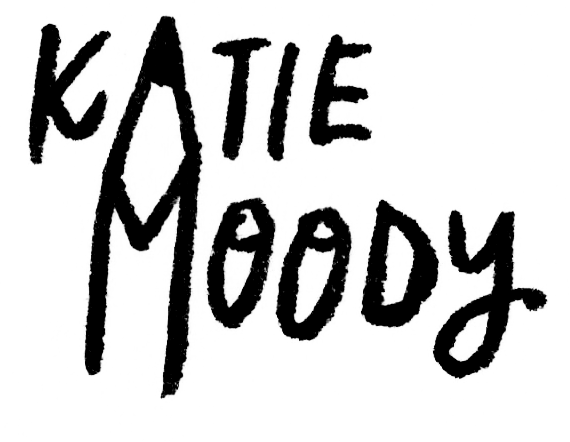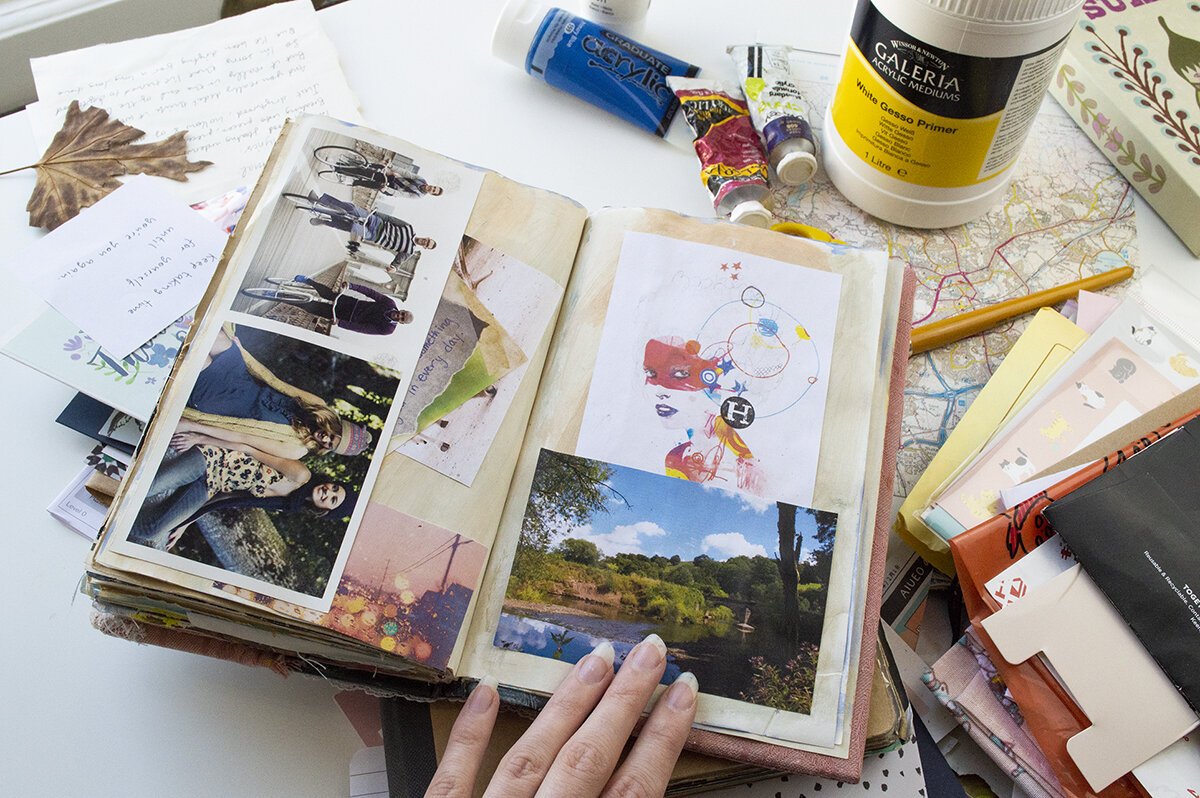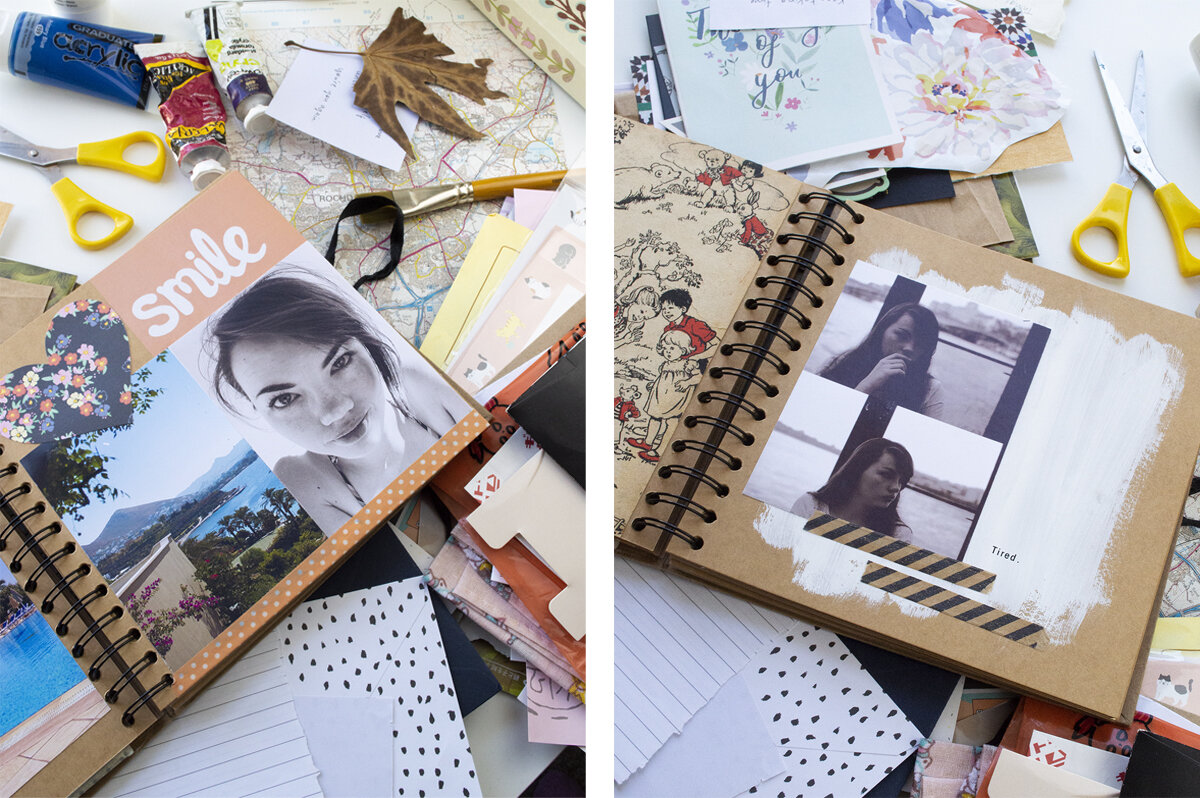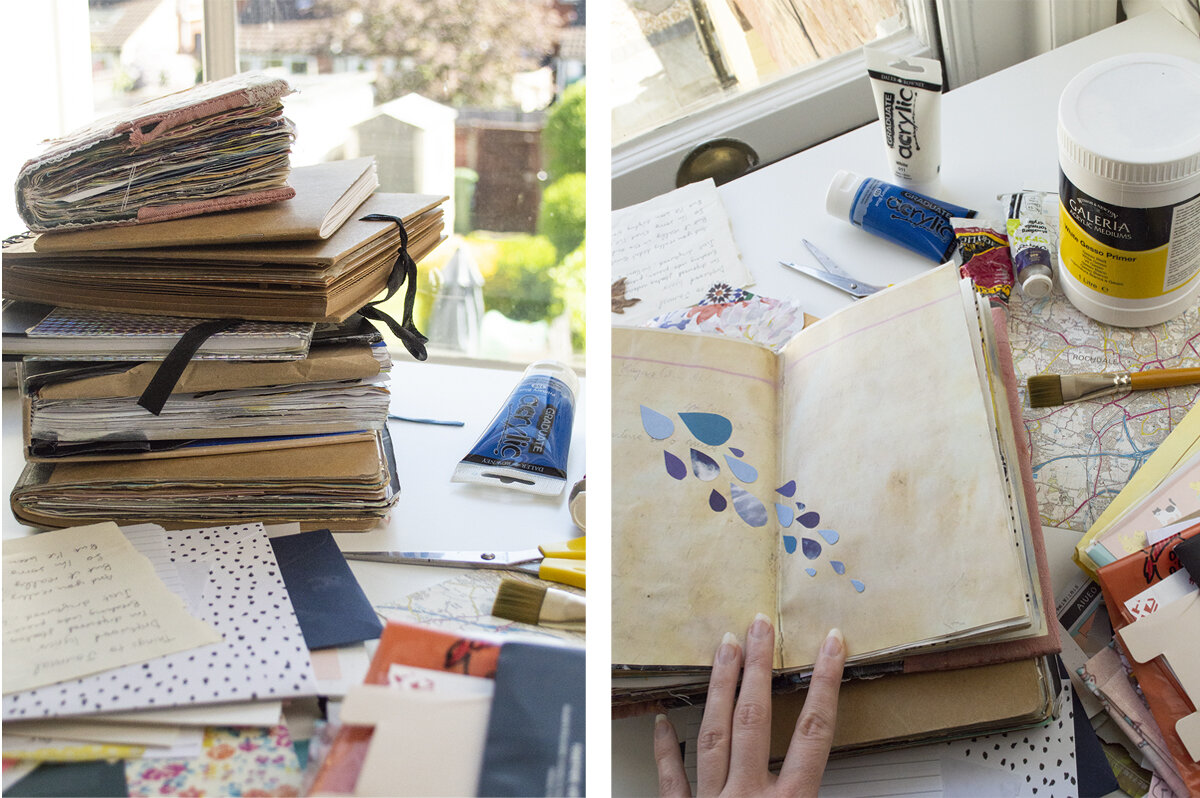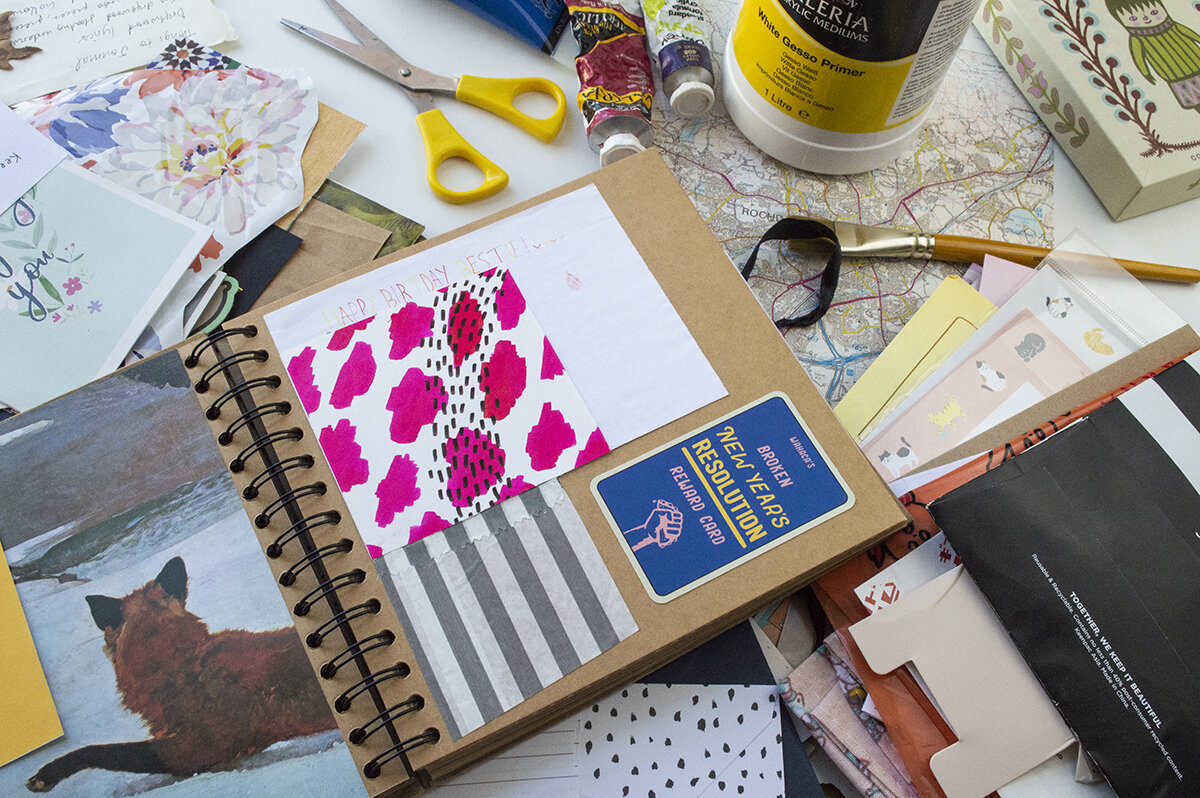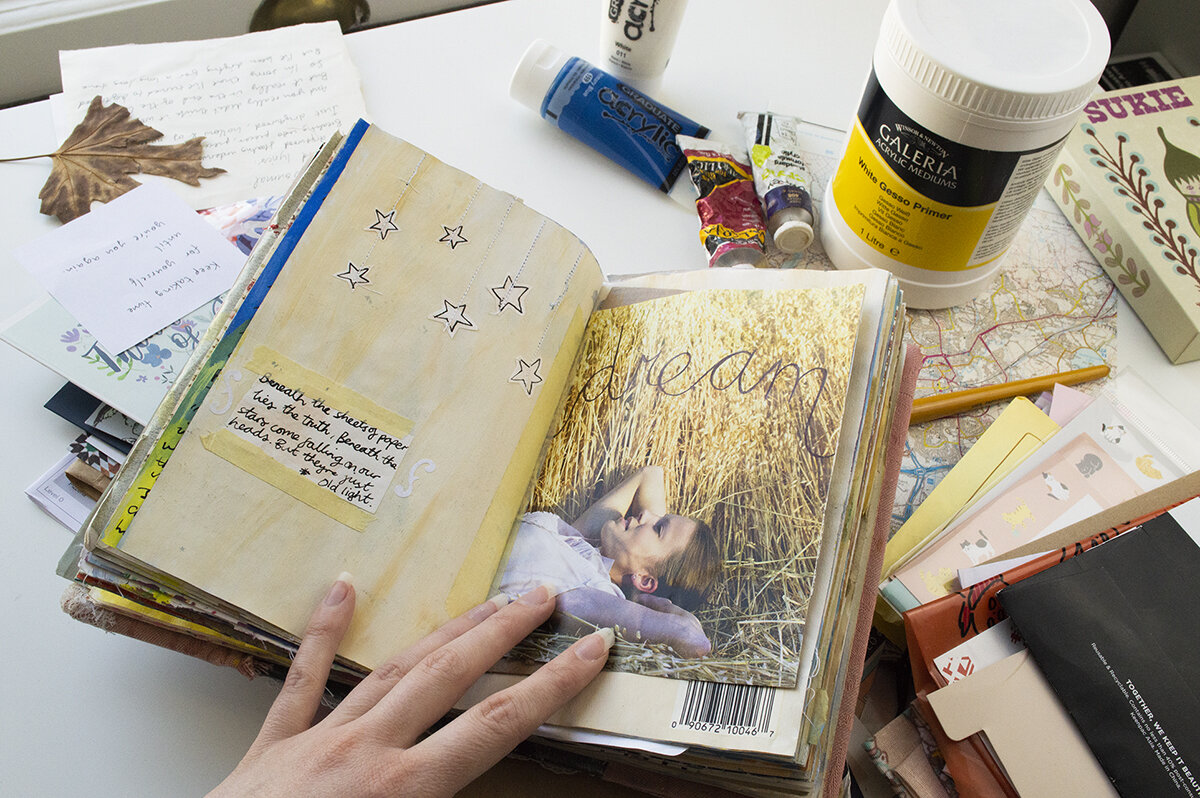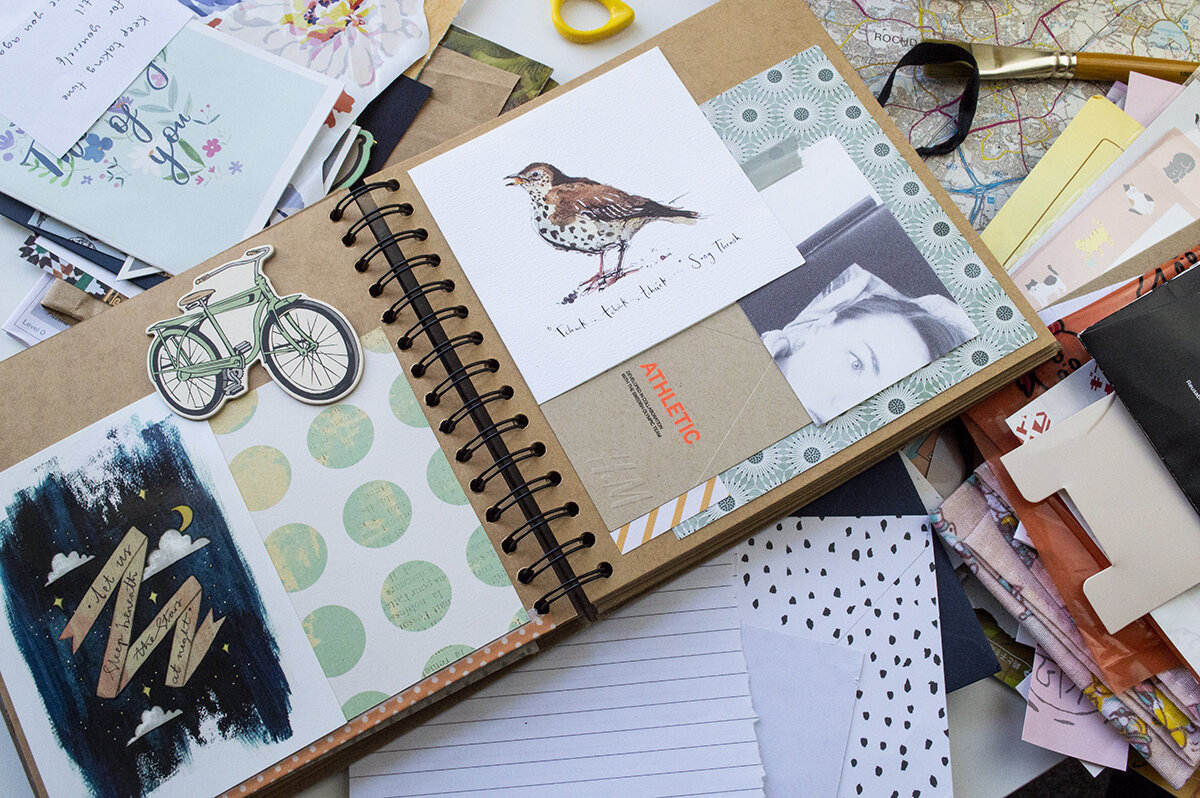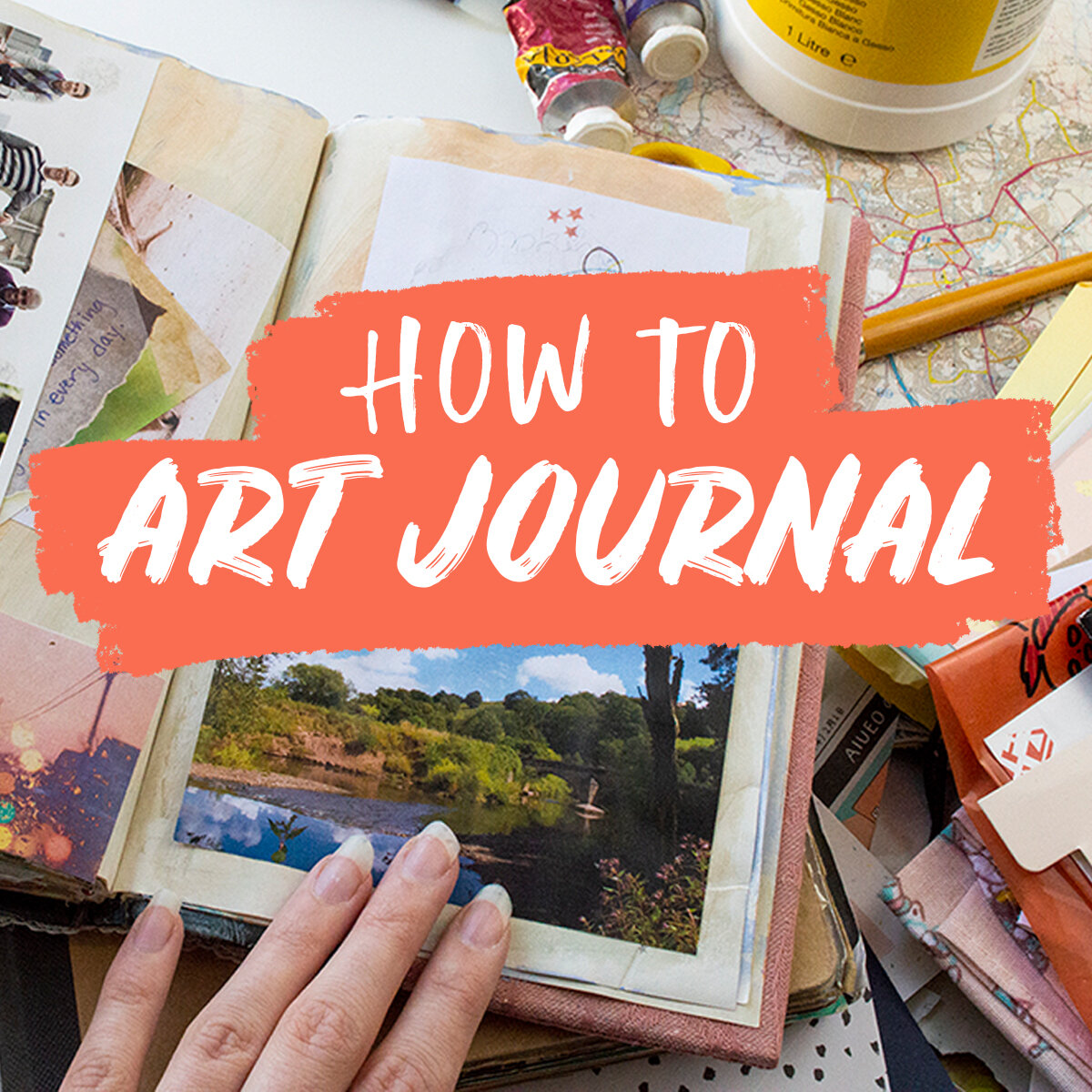How to art journal
Today I’m sharing a step by step for how to make an art journal! Art journaling is something I’ve been doing for years, and with us all in lockdown at the moment, it feels like the perfect time to share how start an art journal.
Art journaling is very different from bullet journals and planners - less about the aesthetics and more about getting your thoughts, feelings and creativity down on the page. Instead of being particular about the neatness and the clean lines, it’s more about the process and the mindfulness of creation.
That being said, of course, an art journal is what you make it! I definitely use mine as a cathartic exercise and one I really, really enjoy. I used to be prolific in creating my art journal spreads, especially as an art student at university and before that, navigating those tricky teenage years. My art journal became a form of therapy, and a good way to release and process my feelings in a manageable way.
Looking back through them helps me to not only see my journey and process, but it is genuinely a lovely thing to view, no matter the emotions at the time. It’s why I love creating, and why I encourage creativity in a traditional way. Nothing beats flicking through a scrapbook, a sketchbook or an art journal! Such a tangible piece of art (and it is a piece of art), instills a sense of pride in what we’ve made. So not only is it a good way to be creative and process our thoughts and feelings, it’s a diary for you to look back on, too.
Some of my spreads aren’t meaningful. Sometimes they include a snippet of a thought or a song quote that really stuck in my brain. A lot of pages are paint splatters and collage and not deep or meaningful at all! I just wanted to create, and that in itself is a good thing to do.
I wanted to write this post to show you the benefits of keeping a journal, and also some jumping off points to start you off if you’d like to create one for yourself.
The journal itself
My very first art journal was an old Harry Potter notebook, before trying out ring-bound sketchbooks, blank page notebooks and thicker paged sketchbooks. Seeing as we’re all in lockdown at the moment, you may be limited in supplies but that doesn’t need to stop you. You really can use anything you have, whether that’s a lined notebook or an old sketchbook you no longer use.
I prefer using blank paper and also a reasonably thick stock, so those are my go to. A lot of the backgrounds you create can be made with collage and paint or other art materials, so it doesn’t matter so much if it’s lined or patterned already. If you’re planning on filling your art journal with paint, then the main thing to watch out for is the thickness of your pages, as you’ll need a thick stock to hold your medium. If you’re using collage or coloured pencils, then it doesn’t matter so much.
Another thing to think about is the binding. I’ve never let this stop me before but if you’re making thick pages that are collaged and heavy, the spine of your book might struggle a little. By the time you’ve finished your art journal, it might be bursting at the seams or falling apart. Some people love this look, and I have held mine together with elastic bands before, but it’s worth noting. I use a mix of collage and paint in my books and they’ve been full and don’t sit flush anymore, but they hold together and work fine!
Remember not to get hung up on what you’re using - it doesn’t have to be perfect. The great thing about art journaling is that it’s generally for your eyes only, and it’s about the process rather than the end result.
Backgrounds
Now you’ve chosen your journal base, it’s time to fill it. I usually go spread by spread but you can pick any random page or start wherever you like. It doesn’t have to be linear like a reading book, just go with your gut.
I tend to always start with a background, as I don’t like a blank white page. Depending on your preference, you can go straight in with your journaling, but I always get a little daunted when the page is completely empty!
My backgrounds are made using a mixture of collage, paint, or both. Sometimes when I want to journal I just need to scribble down a note or a thought, and I don’t have the time to sit down, get the paints out and go full on creative. So I often bulk create a few backgrounds in advance, and add to it with embellishments or journaling when I have time or the inclination.
Collage backgrounds
I keep a box full of collage bits - magazine cuttings, doilies, old packaging. Even things like the inside of security envelopes, or brown paper packages and recycling can make great bases. I keep pages ripped from magazines, brown envelopes, menus and business cards. I collect every sticker I can, even adding in receipts to create a background that I then painted over to create a neutral but textured base. It’s amazing what you can find when you look past what it’s supposed to be!
Paint backgrounds
Some days I’ll use bright and bold colours, other days I’ll keep it neutral. A great investment for art journaling is a big tub of white gesso. It’s like white paint but it’s cheaper and is great for laying over collage or making a base. It’s a chalky, matte texture so you can colour over it with pencils and or apply glue over it without it slipping. Think of it as a primer to your page.
I don’t use my art journal for ‘actual’ painting, like landscapes or drawings. You absolutely can and it can almost be a sketchbook/journal hybrid, but I always find I worry too much about the end result if I’m actually trying to make it look like something. Instead, I just use a paintbrush to create brush strokes and don’t worry about making it into something. I’ll paint random abstract shapes, add texture by dabbing at it with paper towel or not filling the whole page at all. I’ll smear odd bits of paint over a corner, create a border, start on one page and then flip halfway through the book to add more to a different spread.
(One tip here if you’re wanting to create multiple background pages with your paint-y palette without waiting for it to dry, is to use a plastic poly-wallet whilst the backgrounds dry when flipping your book to stop the pages sticking together.)
I also find art journaling is a great way to use up excess paint from other projects. When I create my illustrations or paintings, there’s bound to be paint left on the brush or palette. An art journal is a good way to use it up and have less waste!
Sometimes backgrounds can stay as they are. You can come back to them later or you can keep filling and filling if it makes your heart happy. They are pieces of art themselves, even without adding your journaling. The cutting and sticking of collage or the motion of painting back and forth can be creative therapy in itself.
Decoration, embellishment and other stuff
I add anything and everything to my pages. I have a big box full of things ‘to journal’. I have old letters, birthday cards, leaving cards, found ephemera like receipts, stamps ripped off envelopes, ancient postcards.. Some things I keep for the memories, and others I keep just because. I use stickers, washi tape and stamping on my pages, and sometimes I decorate the spread with a simple pencil scribble or doodle. There really are no rules here - use whatever you like!
To stick things to the page, I use a classic glue stick, but if it’s a piece of paper or a larger collage piece, I like to use tape runners. For more 3D items (like chipboard pieces - remember we have to close the book at some point!), I use a liquid glue like PVA.
Writing
Ah, the writing. This is often where we get stuck. We worry too much about what we say, what we’ll write. We care too much about our handwriting or a spelling mistake. The thing to remember is that we want to switch off. This journal is for us and nobody else.
A lot of people suggest just writing the things that come to your head. It is definitely a thing that becomes easier with practise, and it’s not easy to check in with your mind at first. Like I said earlier, it could just be a song lyric that’s stuck in your head! I like to write down quotes from Pinterest too, so don’t worry if it’s not even your own thoughts. It could just be something that resonated with you, or you just liked the way it sounded.
If you want to go deeper with your journaling and tap into it like therapy, try starting with lists. List what you did today. List how you felt. If you start writing it down like facts, I find it easier to tap into it.
Without going too off tangent, just imagine yourself talking to a friend about your day. Write down your emotions but don’t judge what you write. View your thoughts and feelings as if you were being told them by a friend, not yourself. If you’re angry about something you did or the way you reacted, imagine your friend telling you that. Would you tell them they were being stupid? Or would you tell them that it was a completely rational thing to feel, and even if it wasn’t, you can justify it with the other things going on in your life.
When you’re art journaling, just let it all out and write what you want to write, but don’t judge or be angry with what spills out on the page. Art journaling is a creative process and being creative is about taking risks and ignoring judgement. Creativity is proven to help you see things differently and help us adapt our thinking, as well as helping us to acknowledge and recognise our own skill and unique ability to create something from nothing. It encourages self expression and is a great way to help process our feelings and personal experiences.
Final note
The hardest part about art journaling is starting. I often look at bujos and planners and feel a pang of jealousy at their beautiful, neat notebooks. But with art journaling, they’re so uniquely personal that it really is an extension of you. Yes there’ll be beautiful spreads and examples on pinterest and instagram, but they’re not yours. You may have an idea in your mind about what your art journal will look like, but it will rarely turn out that way - that’s OK. It’s not easy to translate it onto your page, so instead of worrying about the end result, just enjoy the process. The joy is in creating it!
If you hate painting and you don’t want to get messy, or you hate trying to make it look ‘pretty’ and just want to go in with the writing part, do it that way! If you don’t want to write anything in it at all, and just enjoy the collaging, the colouring, the going crazy with colour part, do that. This is the whole point of art journaling; it’s for you and nobody else. Feel free to share it on the internet if you want to, but remember that’s not the end results. You don’t have to take pictures and share it, I certainly wouldn’t put my super secret, raw pages on the internet. But hopefully they’ll give you a bit of inspo and you can create your own wonderful art journals :)
I hope you’ve found this post helpful! If you have any questions or want to know more specific details, let me know in a comment under this blogpost or send me a DM on Instagram! If you create a journal off the back of these, please let me know. It makes me so happy when I’ve inspired someone to create, so be sure to tag me in any photos or just let me know in a message!
Finally, I’d love for you to join in my Instagram Challenge next week - whether you’re an old hat or brand new to art journaling! It’s absolutely no pressure, just a go-with-the-flow sort of thing. I’ll be in my Instagram stories daily walking you through the process and talking through my journals and step by step how to each day on the grid. If you do join in, use the hashtag #katiesjournalchallenge and I can’t wait to see you over on Instagram!
Like this post? Pin it on Pinterest so you can come back to it later!
